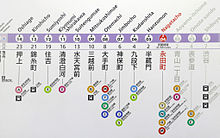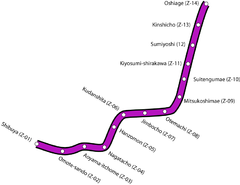Tokyo Metro Hanzōmon Line
This article needs additional citations for verification. (April 2022) |
| Tokyo Metro Hanzōmon Line | |||
|---|---|---|---|
New CS-ATC | |||
| Maximum incline | 3.5% | ||
| |||
The Tokyo Metro Hanzōmon Line (東京メトロ半蔵門線, Tōkyō-metoro-hanzōmon-sen) is a subway line in Tokyo, Japan, owned and operated by Tokyo Metro.
Overview
The 16.8 km (10.4 mi) line serves the wards of
The Hanzōmon Line has direct interchanges with all other Tokyo Metro and Toei lines. It connects with the Tokyo Metro Ginza Line at five stations (the four stations between Shibuya and Nagatachō, as well as at Mitsukoshimae Station.
The line is named after the west gate of the Imperial Palace (Hanzōmon), which in turn is named after 16th century samurai Hattori Hanzō, who was important to the founding of the shogunate which built the palace. The Hanzōmon Line's color on maps and station guides is purple, and stations carry the letter "Z" followed by a two-digit number.
According to the
Station list

- All stations are located in Tokyo.
- All services stop at every station.
| No. | Station | Japanese | Distance (km) | Transfers | Location | |
|---|---|---|---|---|---|---|
| Between stations |
From Shibuya | |||||
| Tokyu Den-en-toshi through services: | Via the DT Chuo-Rinkan
| |||||
| Z01 | Shibuya | 渋谷[* 1] | - | 0.0 |
|
Shibuya
|
| Z02 | Omotesandō
|
表参道 | 1.3 | 1.3 |
|
Minato |
| Z03 | Aoyama-itchōme | 青山一丁目 | 1.4 | 2.7 |
| |
| Z04 | Nagatachō | 永田町 | 1.4 | 4.1 |
|
Chiyoda |
| Z05 | Hanzōmon | 半蔵門 | 1.0 | 5.1 | ||
| Z06 | Kudanshita | 九段下 | 1.6 | 6.7 |
| |
| Z07 | Jimbōchō | 神保町 | 0.4 | 7.1 |
| |
| Z08 | Ōtemachi | 大手町 | 1.7 | 8.8 |
| |
| Z09 | Mitsukoshimae | 三越前 | 0.7 | 9.5 |
|
Chūō |
| Z10 | Suitengūmae | 水天宮前 | 1.3 | 10.8 |
| |
| Z11 | Kiyosumi-shirakawa | 清澄白河 | 1.7 | 12.5 | E Ōedo Line (E-14) | Kōtō
|
| Z12 | Sumiyoshi | 住吉 | 1.9 | 14.4 | S Shinjuku Line (S-13) | |
| Z13 | Kinshicho
|
錦糸町 | 1.0 | 15.4 |
|
Sumida |
| Z14 | Oshiage | 押上[* 3] | 1.4 | 16.8 |
| |
| Tobu through services: | Via the TS Tobu Skytree Line & TI Tobu Isesaki Line to/from Kuki Via the TS Tobu Skytree Line & TN Tobu Nikko Line to/from Minami-Kurihashi | |||||
- ^ Shibuya is shared by both Tokyu Corporation and Tokyo Metro; Tokyu Corporation manages the station.
- ^ Due to the distance between the Ginza and Hanzomon/Den-en-toshi lines at Shibuya, transfers between the two lines are announced at Omote-sando.
- ^ Oshiage is shared by both Tobu Railway and Tokyo Metro; Tokyo Metro manages the station.
Rolling stock
Current
All Hanzōmon Line rolling stock owned by Tokyo Metro are stored and maintained at Saginuma Depot (ja:鷺沼車両基地), located near Saginuma Station on the Tokyu Den-en-toshi Line.
- Tokyo Metro 18000 series[4]
- Tokyo Metro 08 series[5]
- Tokyo Metro 8000 series
- Tokyu 2020 series
- Tokyu 5000 series
- Tobu 50000 series
- Tobu 50050 series
-
Tokyo Metro 18000 series
-
Tokyo Metro 08 series
-
Tokyo Metro 8000 series
-
Tokyu 2020 series
-
Tokyu 5000 series
-
Tobu 50050 series
Former
-
Tokyu 8500 series
History
The Hanzōmon Line was first planned in 1968, along with the
Construction began in 1972 and the majority of the line was expected to open in 1975. However, the
However, the next extension posed political problems, as the original plan had the line run directly under the
The line, station facilities, rolling stock, and related assets were inherited by Tokyo Metro after the privatization of the Teito Rapid Transit Authority (TRTA) in 2004.[7]
The Ministry of Transportation recommended in 2000 that the line be extended to its intended terminus in Matsudo by 2015. However, Tokyo Metro stated in its initial public offering that its construction operations would cease once the Fukutoshin Line is completed, which cast some doubt as to whether the Matsudo extension will actually be built.
Notes
a. ^ Crowding levels defined by the Ministry of Land, Infrastructure, Transport and Tourism:[8][9]
- 100% — Commuters have enough personal space and are able to take a seat or stand while holding onto the straps or hand rails.
- 150% — Commuters have enough personal space to read a newspaper.
- 180% — Commuters must fold newspapers to read.
- 200% — Commuters are pressed against each other in each compartment but can still read small magazines.
- 250% — Commuters are pressed against each other, unable to move.
Bibliography
References
- ^ Tokyo Metro station ridership in 2017 Train Media (sourced from Tokyo Metro) Retrieved July 23, 2018.
- ^ Tobu Timetable, 16 March 2013, p.168-176
- ^ Metropolis, "Commute", June 12, 2009, p. 07. Capacity is defined as all passengers having a seat or a strap or door railing to hold on to.
- ^ 東京メトロ「兄弟車」有楽町線・副都心線17000系と半蔵門線18000系 [Tokyo Metro "Brother Car" Yurakucho Line & Fukutoshin Line 17000 series and Hanzomon Line 18000 series]. Mynavi News (in Japanese). Mynavi Corporation. 2021-09-25. Retrieved 2022-06-20.
- ^ Suzuki, Riki (March 2003). 営団地下鉄08系 [Teito Rapid Transit Authority 08 series]. Japan Railfan Magazine (in Japanese). Vol. 43, no. 503. Japan: Koyusha Co., Ltd. pp. 54–60.
- ISBN 4-06-366218-7.
- ^ "「営団地下鉄」から「東京メトロ」へ" [From "Teito Rapid Transit Authority" to "Tokyo Metro"]. Tokyo Metro Online. 2006-07-08. Archived from the original on 16 May 2012. Retrieved 29 May 2022.
- ^ "混雑率の推移".
- ^ Kikuchi, Daisuke (6 July 2017). "Tokyo plans new effort to ease commuter hell on rush-hour trains". The Japan Times. Archived from the original on 6 July 2017.
Works cited
- Shaw, Dennis; Morokawa, Hisashi (1992). Tokyo Subways. Osaka, Japan: Hoikusha Publishing Co., Ltd. ISBN 4-586-54045-1.
External links
- Tokyo Metro website (in English)








